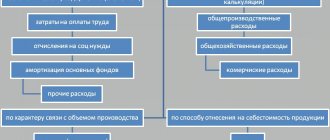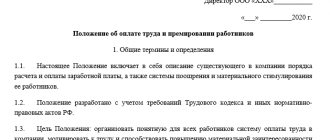Organization of payroll accounting at the enterprise
In order to organize labor and wage accounting at an enterprise, the accounting policy specifies what forms of primary documents will be used for this purpose.
At the same time, with the entry into force of the accounting law of December 6, 2011 No. 402-FZ, the use of unified forms ceased to be mandatory. But many accountants, when organizing payroll accounting at an enterprise, give preference to the forms of primary documents approved by Goskomstat Resolution No. 1 of January 5, 2004. The primary documentation for accounting for the movement of personnel are orders (on hiring, dismissal, transfers, provision of paid leave, etc.). d.). For each hired employee, a personal card is created and a personal account is opened.
Data on accrued and paid salaries, amounts of deductions and deductions are entered into a personal account, which is opened, as a rule, for a year. Data is transferred to personal cards from time sheets, sick leave sheets, orders for piece work, orders (on making deductions or calculating bonuses), etc.
You can learn about the procedure for organizing primary accounting at an enterprise from the article “Procedure for organizing primary accounting”.
Payroll accounting - minimum theory
The payroll accounting account is accounting account 70 “Settlements with personnel for wages” . We will start by presenting the entire process of the payroll section in the following form:
- An employee works at the enterprise, performing his functions in accordance with his job description. And the company pays for the employee’s work
- The company pays monthly salaries to employees
- The company issues wages to the employee.
By this point, we already know the term payroll - this is the wage fund, which is the sum of all accruals for employees. It is customary to understand the term payroll as the sum of all employee accruals for the month. However, nothing prevents you from telling your payroll for six months or a year. Or the payroll of all sales representatives, accountants, and administrative staff.
The work of the payroll accounting section consists of two steps:
- Documentation of personnel information for employees: hiring and dismissal, vacation orders, registration of sick leave, absenteeism, all sorts of bonuses, assistance, etc.
- Direct calculation and payment of wages with printing of the results on: payslips, payroll and payroll.
To issue wages, a cash desk will be used if wages are issued in cash, or a bank if wages are transferred to people’s cards.
An employee's income is subject to tax. This tax is called “Individual Income Tax” (NDFL). Currently, this tax is considered a percentage of accrued wages and is 13%. The amount of calculated personal income tax is withheld by the company from the employee’s salary, thereby reducing the amount of money to be issued.
Wages were calculated - 10,000 rubles. Personal income tax of 13% of the accrued amount will be equal to 1300 rubles. “In hand” (via bank or cash desk) the employee will receive 10,000-1,300 = 8,700 rubles.
What does the salary consist of? There are two main methods of calculating wages: time-based and piece-rate wages.
Piece wages . The essence of this system, as you guessed, will be the saying, “as you trample, so shall you burst,” namely, as much as you do, so much you receive. For each work performed, there are prices, standards, and indicators. This type of payment is common in agriculture, in production, among those workers who are directly involved in production: plowing, cleaning areas, etc.
Time-based wage system . With such a system, what comes first is not the result of the work done in quantity and quality, but the time spent at the enterprise. It is assumed that there are norms of time per month during which a person must be at the workplace and perform his job duties.
The standard working time per month can be expressed in hours or days.
The time-based labor system is based on the concept of wages. Salary is the base salary amount from which the entire calculation of remuneration begins.
If for a “piece-worker” the basic amount of his salary is prices, norms, indicators, then for a “time-worker” it is salaries.
It follows from a person’s obligation to be at the workplace “standard working hours per month” that the amount of the salary will be equal to its entire amount if the person “worked” all the time during the month. If a person missed work or was unable to go to work, then the full amount of the salary is recalculated in proportion to the days or hours worked.
The salary amount may be based on the number of days worked, or on the number of hours worked. All this is indicated in the employment contract that a person concludes with the company at the time of his employment.
Let’s say a person’s work rate in the month of April is 20 in days and 160 in hours. Let’s say a person’s salary is 10,000 rubles. and accounting system:
By day The man did not go to work for 6 days. Salary = (10000/20) * (20-6) = 7000 rub. Personal income tax = 7000*13% = 910. In hand = 7000 – 910 = 6090 rub.
By the hour The person did not work 12 hours in the current month. Salary = (10000/160)*(160-12) = 9250 rub. Personal income tax = 1203 rub. In hand = 9250 - 1203 = 8047 rub.
In addition to two basic charges (payment based on salary, payment based on piecework) and one personal income tax deduction, various allowances and deductions can be added to the salary.
Supplements are bonuses for something, additional amounts, etc. Allowances have their own calculation formulas. As a rule, this is either a fixed amount or a percentage of the salary.
Deductions are amounts that reduce wages. The most common deductions are alimony, payments under writs of execution, payment of cellular communications from a work phone in excess of the norm (i.e. at one’s own expense), deduction from reporting (the reporting person did not return the money to the cashier), etc.
Accounting for settlements with personnel for wages - account for accounting
To record calculations for remuneration of personnel, accounting account 70 is used - it summarizes the relevant information for each employee of the enterprise.
The debit of the account shows the amount of paid wages, as well as the amount of deductions (for taxes (account 68), for executive documents (account 76), shortages (account 73) and damage to valuables (account 94), etc.) . If an employee does not receive his accrued salary on time, then this amount is reflected in the debit of the account. 70 in correspondence with account. 76.
The loan displays:
- the amounts of accrued wages in correspondence with the accounts in which the corresponding costs are collected;
- amounts of accrued vacation pay in correspondence with the account. 96;
- accrued dividends to the company's employees in correspondence with the account. 84.
Enterprises must organize analytical accounting according to accounting 70 for each employee.
Find out how to take into account labor costs in kind in ConsultantPlus . If you do not have access to the K+ system, get a trial online access for free.
About the accounting register, which summarizes information about settlements with employees for wages, read in the article Features of the balance sheet for account 70 .
Interaction of payroll accounting with other accounts
Let's immediately complete the task ourselves. I am sure you are already ready for its implementation. We talked so much about employees in the minimum theory section; we mentioned them in previous articles. I'm sure you can handle it. Write out accounting accounts or accounting sections that are associated with employees. If required, use the chart of accounts.
Answers are available only to subscribers!
If you are subscribed to blog updates by email, enter the access code from the last mailing letter. To receive an access code, subscribe to blog news.
Accounting: salaries to be issued
Accounting for wages and deductions from them should also clearly reflect the amount payable to employees. In this regard, accrued on the debit of the account. 70 wages will be reduced.
Personal income tax is necessarily withheld from the salaries of all employees - for this purpose, Dt 70 Kt 68 is posted.
Payment of wages (without personal income tax and deductions on writs of execution, etc.) is made through the cash register or by transferring funds to the employee’s card account. When issuing a salary account. 70 corresponds with account. 50 (51).
You can find out how salaries are transferred to a card in the article “Procedure for transferring salaries to a bank card”.
Payroll accounting: primary documents
This section includes a huge number of primary documents. All of them are designed to record employee events that affect his salary: an increase or decrease in it.
The primary documents of this section can be divided into two types: personnel documents and payroll documents.
Throughout the month, personnel documents to document the situation regarding the employee that affects wages. For example: a person was sick, went on vacation, did not go to work, went on a business trip. These situations interrupt his time at work, don’t you agree? Or maybe the person got a bonus this month?
After completing all personnel documents and at the end of the month, a special document “Working Time Sheet” is created.
The last action of the month will be payroll documents . Typically this document is called “Payroll”. And then comes the printing of pay slips and pay slips. After paying wages to employees (by cash or bank), the accountant draws up documents for payment of wages.
Accounting for labor and wages among simplifiers
Salary accounting for the OSN and simplified tax system is carried out in the same way, with the exception that not all simplifiers will be able to reduce their income by the amount of labor costs. This right is retained only for those simplifiers who have chosen the object of simplified taxation “income minus expenses”.
ConsultantPlus experts explained in detail how to take into account labor costs under the simplified tax system. Study the material by getting trial access to the K+ system for free.
Checking mutual settlements
Checking mutual settlements with an employee
You can check mutual settlements with an employee using the report Balance sheet for the account “Settlements with personnel for wages” in the Reports section - Standard reports - Account balance sheet.
The absence of a final balance in the account “Settlements with personnel for wages” on the day of payment of wages means that the wage arrears to Gordeev N.V. absent.
Checking settlements with the budget
To check the calculations with the budget for personal income tax, you can create a report Analysis of account 68.01 “Personal income tax when performing the duties of a tax agent”, in the section Reports - Standard reports - Account analysis.
In our example, wages were paid on August 10, so the end date of the report should be August 13 (August 11 and 12 are Saturday and Sunday), i.e. the closest working day after the day of wage payment.
The absence of a final balance in account 68.01 “Personal income tax when performing the duties of a tax agent” means that there is no debt to pay personal income tax to the budget.
See also:
- General scheme for setting up salary and contribution accounting
- Salary settings in 1C
- Payroll
- Advance payment via cash register
Did the article help?
Get another secret bonus and full access to the BukhExpert8 help system for 14 days free of charge
Salary. Accounting
Example.
In the organization, according to the collective agreement, an advance form of payment has been established, in which for the first half of the month, on the 15th of each month, an advance is paid based on the official salary (tariff rate) for the working days actually worked, and for the second half of the month, wages are paid on the 5th next month.According to the order of the organization, an employee of an organization (financial department) is set: salary for the position held - 10,000 rubles, bonus for length of service - 20%; bonus - 30% of the basic salary.
In March 2005, the organization had 22 working days.
The amount of the advance for the first half of the month is 4545.45 rubles (10,000 rubles / 22 days according to the work schedule in March 2005 x 10 days actually worked).
The amount of wages for a full month is 15,600 rubles, including: salary - 10,000 rubles (the employee actually worked the entire month); long service bonus - 2,000 rubles (10,000 rubles x 20%); bonus - 3,600 rubles ((10,000 rubles + 2,000 rubles) x 30%).
Income tax withholding - 2,028 rubles (15,600 rubles x 13% - for tax purposes, total income since the beginning of the year exceeded 20,000 rubles, and therefore standard tax deductions are not provided).
For delivery on April 5, 2005, 9,026.55 rubles are due (15,600 rubles - 2,028 rubles - 4,545.45 rubles).
In accounting, settlements with employees should be recorded using the following entries.
In further examples to account 69 “Calculations for social insurance and security”, the use of subaccount 69-4 “Calculations for compulsory insurance against industrial accidents and occupational diseases” is provided.
Account correspondence Amount, rubles Contents of operation Debit Credit 1. On the day of payment of the advance for the first half of the month (March 15, 2005): 70 50 4 545,45 Advance payment for the first half of the month 2. By calculating wages for the month and calculating deductions (at the end of March - beginning of April 2005): 26 70 1 5600 Wages accrued for March 70 68-1 2 028 Personal income tax withheld 26 69 4 056 The unified social tax and contributions to the pension fund were calculated from the accrued amounts for wages (RUB 15,600 x 26%) 26 69-4 62 From the accrued amounts of wages, insurance contributions are calculated for compulsory social insurance against accidents at work and occupational diseases (for example, the organization is classified as occupational risk class III, which corresponds to a tariff of 0.4%) (15,600 rubles x 0.4% ) 3. When paying wages for the second half of the month (April 5, 2005): 70 50 9 026,55 End of the example.
What is the basis for organizing wages?
Just like accounting for labor and wages, the process of organizing payment itself consists of several stages:
- Selecting a payment system;
- Determining criteria for additional payments and calculating their amounts;
- Determining the amount of remuneration depending on the position held.
Plus, it is imperative to take into account the payments that are due to employees during the time when they do not fulfill their duties. These include sick leave, vacation money, etc.
It is also necessary to take into account that in order for the salary to perform the function of stimulation, it is necessary to individualize it as much as possible. That is, the employee must understand that his income will directly depend on his productivity, the quality of work performed, etc.
Nowadays, in order to retain a truly high-quality specialist, he needs to be interested. Employers should remember that although salary is the main criterion when choosing a job, other factors also need to be taken into account. Even at the interview stage, you can find out what is important for the applicant.
For some, this is an opportunity for self-improvement and career growth; for others, it is additional bonuses in the form of training at the expense of the company; for others, it is important to feel like part of a team. And if this specialist is important to the organization, it is in its interests to provide him with everything he needs.
How to organize
As we noted above, each enterprise must develop and approve an accounting policy. This document is the basis for organizing the accounting of an economic entity. In terms of recording wage transactions, it is necessary to take into account the following important points:
- Primary documents. It is necessary to indicate in which forms and forms the primary information about operations will be reflected. It is permissible to use standardized forms or develop (modify) your own document forms.
- Accounting documentation. It is necessary to determine the forms of accounting journals, books, orders in which information about primary documentation will be collected. Payroll reporting forms should also be approved.
- Synthetic and analytical accounting of wage calculations should be organized taking into account the specifics of the enterprise’s activities in terms of developing a working chart of accounts.
- Document flow. It is necessary to approve the procedure for interaction between all services, departments and structural divisions of the enterprise in terms of reliable completion of primary and accounting documentation, as well as timely submission to responsible persons.
Check whether this information is reflected in your accounting policies. Read more about the features of drawing up and approving a key financial document in the article “Drawing up the organization’s accounting policies.”
Functions of labor accounting and payment accounting
There are several reasons why accounting for labor and its payment is so important for any company, regardless of its size and type of activity.
When considering the functions that such control performs, it is necessary first of all to say that it helps to make all payments to employees on time. This is very important, because every employee has every right to contact the relevant authorities and demand compensation for not receiving the payment due to him within the established time frame. And if his request is granted, the company will suffer additional losses.
Also, such accounting helps to correctly determine the cost of manufactured products or services.
Based on the data received, the accountant calculates deductions that will be transferred to the Social Security Fund.
When making calculations, an accounting employee is based on certain regulatory documents:
- Staffing table - a document in which all positions and the amounts of salaries due to them are clearly recorded;
- Documents in which prices are recorded;
- Orders that state the fact of accrual of various bonuses or financial assistance.
If the payment is made for one-time work or services, the basis for accounting is the contract. Records can be kept either based on information about one employee or generalized for all personnel. The second option is used more often.






